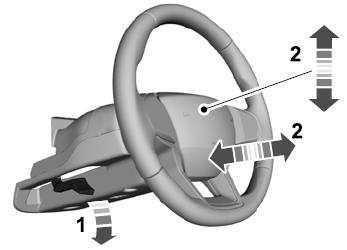Lincoln Aviator 2020-2026 Service Manual / Chassis / Brake System / Parking Brake and Actuation / Removal and Installation - Parking Brake Switch
Lincoln Aviator: Parking Brake and Actuation / Removal and Installation - Parking Brake Switch
Special Tool(s) / General Equipment
| Interior Trim Remover |
Removal
NOTE: Removal steps in this procedure may contain installation details.
NOTE: Move the front seats forward and rearward as necessary to access floor console components.
-
Release the retainers and remove the LH floor console side trim panel.
Use the General Equipment: Interior Trim Remover
.jpg) |
-
Release the retainers and remove the RH floor console side trim panel.
Use the General Equipment: Interior Trim Remover
.jpg) |
-
Open the center console arm rest panel.
.jpg) |
-
Remove the FCIMB.
Refer to: Front Controls Interface Module B (FCIMB) (415-00 Information and Entertainment System - General Information, Removal and Installation).
-
Remove both top console side panel bolts.
Torque: 22 lb.in (2.5 Nm)
.jpg) |
-
Remove both top console side trim panels.
-
Remove the bolts.
Use the General Equipment: Interior Trim Remover
Torque: 22 lb.in (2.5 Nm)
-
Release the retainers and remove the RH and LH floor console side trim panels.
-
Remove the bolts.
.jpg) |
-
Remove both floor console bolts.
-
Remove the bolts.
Use the General Equipment: Interior Trim Remover
Torque: 28 lb.in (3.2 Nm)
-
Remove the screws.
Torque: 17 lb.in (1.9 Nm)
-
Remove the bolts.
.jpg) |
-
Release the clips, detach the console top panel,
disconnect the electrical connectors and remove the console top panel.
.jpg) |
-
Remove the bolts and the parking brake switch.
Torque: 17 lb.in (1.9 Nm)
.jpg) |
Installation
-
To install, reverse the removal procedure.
-
NOTE: Anytime the parking brake switch electrical connector has been disconnected, the EPB system is deactivated and a DTC is stored in the EPB module. Perform the following step to restore the EPB system and clear the EPB module DTC.
Apply and release the parking brake twice within 5 seconds, pausing with the switch in the NEUTRAL position for approximately one-half second between each apply and release. Using a diagnostic scan tool, clear the EPB module Diagnostic Trouble Codes (DTCs).
 Removal and Installation - Parking Brake Actuator Motor
Removal and Installation - Parking Brake Actuator Motor
Removal
NOTE:
Removal steps in this procedure may contain installation details.
NOTE:
LH side shown, RH similar.
With the vehicle in NEUTRAL, position it on a hoist...
Other information:
Lincoln Aviator 2020-2026 Owners Manual: Smart Unlocks for Intelligent Access Keys
This feature helps to prevent you from locking your intelligent access key inside your vehicle’s passenger compartment or rear cargo area. When you electronically lock your vehicle with any door open, the transmission is in park (P) and the ignition is off, the system searches for an intelligent access key inside your vehicle after you close the last door...
Lincoln Aviator 2020-2026 Service Manual: Description and Operation - Exhaust System - Overview
Overview NOTICE: Do not use leaded fuel in a vehicle equipped with a catalytic converter. In a vehicle that is continually misfueled, the lead in the fuel will be deposited in the catalytic converter and completely blanket the catalyst. Lead reacts with platinum to "poison" the catalyst...
Categories
- Manuals Home
- Lincoln Aviator Owners Manual
- Lincoln Aviator Service Manual
- Wireless Accessory Charger (If Equipped)
- Garage Door Opener
- Tire Change Procedure
- New on site
- Most important about car
Adjusting the Steering Wheel - Vehicles With: Manual Adjustable Steering Column
WARNING: Do not adjust the steering wheel when your vehicle is moving.
Note: Make sure that you are sitting in the correct position.
Unlock the steering column. Adjust the steering wheel to the desired position.
Copyright © 2026 www.liaviator2.com

